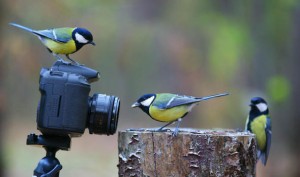Week 9 – 04 September 2016:
ZOOM!
According to its website, Adolfo Suárez Madrid-Barajas Airport in Spain is: “One of the airport capitals of the 21st century.” How exciting! Its four runways have a combined length of 15.5 km (9.6 miles). Four terminals provide for 71 airlines serving 182 domestic and international destinations. Forty-six million passengers used the airport in 2015, which is more than 126,000 travellers each day. All those busy people, and a few birds.
In recent years, the impact on wildlife of noise created by human activities such as traffic and construction has become a topic of considerable interest. Birds in particular seem to be vulnerable to disturbance by human-created noise, if only because many birds use acoustic cues to help avoid predation. What better situation to study the impact of noise on birds than the nosiest spot of all – a busy airport?
In a recent publication, Ignacio Klett-Mingo and Diego Gil of the Universidad Politécnica de Madrid, and Ignaco Pavón of the Museo Nacional de Ciencias Naturales described the results of their study of aircraft noise at Madrid-Barajas airport on the local birdlife. The airport is bordered by a river and a woodland, home to a substantial bird community. When arriving and departing airplanes pass the woodland, peak noise levels can exceed 85 dB. This level of noise is apparently sufficient to cause permanent hearing damage in humans after just eight hours of exposure.
Klett-Mingo and his colleagues placed six bird feeders in the study area, stocking them with peanuts. They documented the behaviour of Great Tits using video recorders placed close to the feeders. Birds living next to a busy airport runway are unlikely to be surprised when an airplane arrives or departs, but do these events disrupt their lives?
Klett-Mingo et al. found that tits changed their behaviour significantly as airplanes passed by. Birds spent less time feeding and more time with their heads up, scanning their environment, spending almost twice as much time being vigilant when aircraft noise was greatest. It seemed as though tits found it necessary to be more vigilant when their world got noisy.
This isn’t surprising. Great Tits, like many other birds, rely on acoustical signals to help warn them about potential predators. For instance, some birds produce alarm calls in threating situations, allowing other birds around them to respond in an appropriate way. When lots of individuals are watching for danger, these signals can allow each of them to spend less time being vigilant, and more time foraging. When things get too noisy, the value of these social signals are lost, and each individual needs to be more wary.
The lost foraging time might be particularly harmful in winter when days are shorter and food is less available. Beyond food challenges, Klett-Mingo speculated that repeated loud noises might increase physiological stress in birds living near runways. Perhaps the increased vigilance by individual tits cannot fully compensate for aircraft noise, resulting in an increased risk of predation, particularly if the noise leads to distraction.
Diego Gil explained to me that there are many bird predators in the study area, including Eurasian Sparrowhawks. The main cause of this abundance is likely the absence of hunting pressure around the airport, but it is also possible that airplane noise makes potential victims more vulnerable, and so the habitat is more valuable for foraging by predators.
Birds do not wear noise-cancelling headphones. Wouldn’t it be interesting to know whether Great Tits exposed to the roar of aircraft at Madrid-Barajas Airport suffer hearing loss?
Klett-Mingo, J. I., I. Pavón and D. Gil. 2016. Great Tits, Parus major, increase vigilance time and reduce feeding efforts during peaks of aircraft noise. Animal Behaviour 115:29-34.
Photo credits: Great tits playing with a camera, photographed by Vadim Trunov – www.express.co.uk/news/nature/624939/amazing-picture-squirrel-and-bird-messing-around-with-camera; first day cover of Great tit and Hortensia stamps from Spain, sent to collector Florian Tirk – worldwidecovers.wordpress.com/2009/09/



